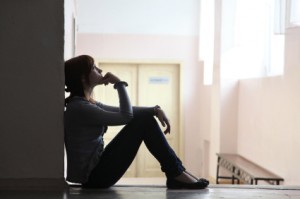The U.S. Preventive Services Task Force recommended in 2009 that primary care clinicians should screen adolescents for depression. But a positive result or screen does not mean that every young person needs active treatment—including psychotherapy and medication—for depression, based on a new study led by Laura Richardson, MD, MPH, of Seattle Children’s Research Institute. The study, “Predictors of Persistence Following a Positive Depression Screen among Adolescents,” was published November 19 in Pediatrics.
“A lot of kids who have an initial positive screen for depression get better without active treatment,” said Dr. Richardson. “Up to 50 percent of more than 100 adolescents in the study who screened positive for depression did not have the same positive screen result six weeks later.”
More than 400 Adolescents Studied
Richardson and team studied 444 youth ages 13 to 17 from Group Health Cooperative, a non-profit healthcare organization that serves Washington state and Idaho residents. Of that group, 113 patients had a positive baseline screen for depression and scored greater than or equal to 11 on a depression screen questionnaire known as PHQ-9 (Patient Health Questionnaire 9-item).
In a prior study using these data, researchers found that with a score of greater than or equal to 11, the PHQ-9 had a sensitivity of 89.5 percent and a specificity of 77.5 percent for detecting youth with major depression.
How many adolescents experience depression in the U.S.? According to the 2008 to 2010 National Surveys on Drug Use and Health, an annual average of 1.4 million girls aged 12 to 17 (12.0 percent) experienced a major depressive episode in the past year—a rate nearly three times that of their male peers (4.5 percent).
Factors that Predict Depression in Adolescents
Forty-seven percent and 35 percent of the same young people continued to screen positive for depression at six-week and six-month follow-up, respectively. After controlling for treatment status, researchers concluded that only two factors were significantly associated with depression symptoms at six months: having a higher baseline depression symptom score and continuing to have a positive screen six weeks after the first screen.
The research team looked at all of the factors associated with depression persistence of adolescents and adults throughout the study. “Anxiety, substance use or abuse, perceived social support and family history are all associated with an increased likelihood of being depressed but they did not predict which adolescents would stay depressed on future screens,” said Dr. Richardson, who is also an associate professor of Pediatrics at the University of Washington and an affiliate investigator at Group Health Research Institute.
Watchful Waiting Works
What’s the option for young people who don’t go into active treatment? “Watchful waiting” should be implemented. “That might mean checking in once a week or every other week with your clinician,” said Dr. Richardson. “During these visits, clinicians should talk with patients about what’s going on in their lives, help them problem-solve any issues that are causing them distress, and encourage them to take better care of themselves by getting more sleep and being active. Parents should be enlisted to provide positive support and help the adolescents achieve these goals.”
It’s also helpful to seek the patients’ input, especially when the patient is a young adult. “A lot of times we will ask, ‘What do you think would be helpful for you? And what would you be interested in changing? And we then help patients come up with a plan,’” she said.
Dr. Richardson said that what started as a study has developed into much more for her as a clinician and researcher. “It’s made me think more about what goes into treating depression in the primary care setting , and how to develop a repertoire of options for how we manage positive depression screens.” She also said that the study findings have changed how she manages care for her own patients.
Resources
Learn more about depression and Adolescent Behavioral Health at Seattle Children’s. Our Psychiatry and Behavioral Medicine team also works to diagnose, treat and prevent problems with emotions and behavior. We see young people up to age 18 – and sometimes longer, if they still need care from experts who treat children.
Co-authors on the study include: Elizabeth McCauley, PhD (Seattle Children’s Research Institute, University of Washington); Carolyn McCarty, PhD (Seattle Children’s Research Institute, University of Washington); David Grossman, MD, MPH (Group Health Research Institute, University of Washington); Mon Myaing, PhD (Seattle Children’s Research Institute); Chuan Zhou, PhD(Seattle Children’s Research Institute, University of Washington); Julie Richards, MPH (Group Health Research Institute); Carol Rockhill, MD, MPH (Seattle Children’s Research Institute, University of Washington); and Wayne Katon, MD(University of Washington).
Acknowledgments
This work was supported by grants from the Group Health Community Foundation Child and Adolescent Grant Program, the University of Washington Royalty Research Fund, a Seattle Children’s Hospital Steering Committee Award and through a K23 award for Dr. Richardson from the NIMH (5K23 MH069814). Dr. Katon has received payment for lectures from the following manufacturers of antidepressant medications: Lilly, Pfizer, and Forrest.


